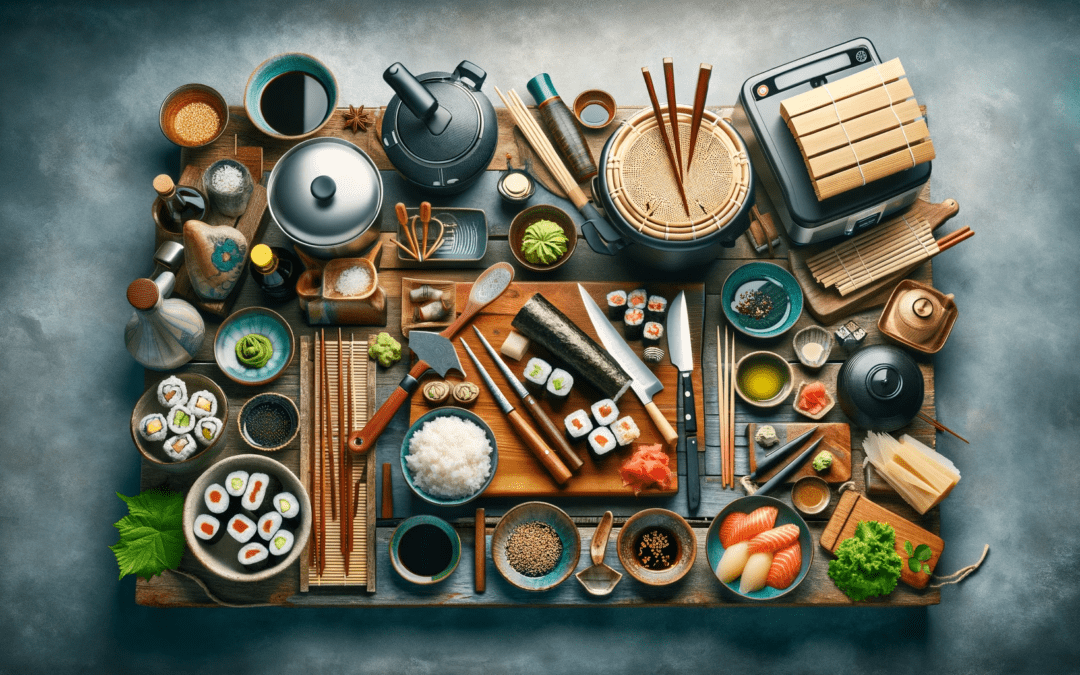Japanese cuisine is renowned for its precision, balance, and distinct flavors. To replicate authentic Japanese dishes at home, having the right tools and ingredients is essential. This article explores the top ten essentials for Japanese cooking, from specialized utensils to key ingredients. Whether you’re an experienced chef or a beginner, these items will help you create delicious Japanese dishes with ease and authenticity.
1. Japanese Chef’s Knife (Gyuto) (Amazon)
- Key Features: High-quality steel, versatile for various cutting tasks.
- Pros: Sharp and durable, essential for precise cutting.
- Cons: Requires regular maintenance, can be expensive.
- Description: A Japanese chef’s knife, or gyuto, is a staple in any Japanese kitchen. Known for its sharpness and precision, it’s ideal for slicing, dicing, and chopping with ease. The high-quality steel ensures durability and longevity. While it can be a significant investment and requires regular sharpening, its versatility and performance make it indispensable for authentic Japanese cooking.
2. Rice Cooker (Amazon)
- Key Features: Consistent cooking, various settings for different types of rice.
- Pros: Perfect rice every time, convenient and easy to use.
- Cons: Takes up counter space, one-dimensional use.
- Description: A rice cooker is essential for preparing perfect Japanese rice, which is the foundation of many dishes. With settings for different types of rice and consistent cooking results, it takes the guesswork out of making rice. While it does occupy counter space and is primarily used for cooking rice, its convenience and reliability are unmatched.
3. Hangiri (Wooden Sushi Rice Bowl) (Amazon)
- Key Features: Large, flat wooden bowl for cooling and seasoning sushi rice.
- Pros: Essential for making authentic sushi rice, enhances flavor.
- Cons: Bulky to store, requires proper care.
- Description: The Hangiri is a traditional wooden bowl used for cooling and seasoning sushi rice. It’s crucial for achieving the right texture and flavor in sushi rice. The wood absorbs excess moisture and helps distribute the seasoning evenly. Although it’s large and requires careful maintenance, using a hangiri is key to authentic sushi making.
4. Japanese Soy Sauce (Shoyu) (Amazon)
- Key Features: Traditional Japanese seasoning, available in various types.
- Pros: Adds depth of flavor, versatile ingredient.
- Cons: Contains sodium, should be used sparingly.
- Description: Japanese soy sauce, or shoyu, is a fundamental ingredient in Japanese cooking. It adds umami and depth to a wide range of dishes. Available in different types like light, dark, and tamari, it can be used in marinades, sauces, and as a seasoning. While high in sodium, its rich flavor is essential in many Japanese recipes.
5. Dashi Stock (Amazon)
- Key Features: Japanese soup stock made from fish and kelp.
- Pros: Base for many Japanese soups and sauces, umami-rich.
- Cons: May not appeal to vegetarians/vegans, has a distinct flavor.
- Description: Dashi stock is the backbone of many Japanese soups, stews, and sauces. Made from ingredients like bonito flakes and kelp, it’s rich in umami and provides a depth of flavor to dishes. While its fish-based version may not be suitable for vegetarians, there are kombu (kelp) and shiitake mushroom alternatives. Its unique taste is integral to authentic Japanese cuisine.
6. Tamagoyaki Pan (Japanese Omelette Pan) (Amazon)
- Key Features: Rectangular pan for making Japanese rolled omelettes.
- Pros: Essential for tamagoyaki, easy to use, compact size.
- Cons: Limited use outside of making tamagoyaki.
- Description: The tamagoyaki pan is specially designed for making Japanese rolled omelettes. Its rectangular shape helps in achieving the layered look of tamagoyaki. While it’s a specialized tool primarily for this dish, its compact size and ease of use make it a fun addition to your kitchen for creating a classic Japanese breakfast or bento box component.
7. Miso Paste (Amazon)
- Key Features: Fermented soybean paste, a staple in Japanese cooking.
- Pros: Adds savory flavor, rich in probiotics.
- Cons: Strong flavor can be overpowering if used excessively.
- Description: Miso paste is a versatile and essential ingredient in Japanese cooking. Used in soups, marinades, and sauces, it adds a savory depth of flavor to dishes. Rich in probiotics, it’s also beneficial for gut health. Miso’s strong flavor means it should be used judiciously to avoid overpowering a dish.
8. Japanese Mandoline (Benriner) (Amazon)
- Key Features: Precision slicing tool, adjustable for various thicknesses.
- Pros: Perfect for thinly slicing vegetables, consistent cuts.
- Cons: Sharp blade requires careful handling, manual operation.
- Description: The Japanese mandoline, or Benriner, is a favorite tool for precisely slicing vegetables. It’s adjustable for different thicknesses, ensuring consistent cuts every time. Ideal for preparing vegetables for sushi, salads, and garnishes. While its sharp blade demands caution, the Benriner is invaluable for quick and precise slicing tasks in Japanese cooking.
9. Sushi Making Kit (Amazon)
- Key Features: Complete set for making sushi at home, includes rolling mat, rice paddle.
- Pros: Great for beginners, provides essential tools for sushi making.
- Cons: Requires practice to perfect sushi rolling.
- Description: A sushi making kit provides all the necessary tools for creating sushi at home. It typically includes a bamboo rolling mat and rice paddle. This kit is perfect for beginners looking to try their hand at making sushi, providing a fun and interactive cooking experience. While rolling sushi requires some practice, the kit makes the process more approachable and enjoyable.
10. Japanese Knives (Santoku, Nakiri) (Amazon)
- Key Features: Specialty knives for different tasks, razor-sharp edges.
- Pros: Precision cutting, exceptional quality, enhances cooking experience.
- Cons: Expensive, requires careful maintenance.
- Description: Japanese knives like Santoku and Nakiri are renowned for their craftsmanship and sharpness. Each type of knife is designed for specific tasks – the Santoku for general use and the Nakiri for chopping vegetables. These knives offer precision cutting and are a joy to use for any cooking enthusiast. However, they are an investment and require regular sharpening and proper care to maintain their edge.
Embracing the art of Japanese cooking at home is an enriching experience, made all the more enjoyable with the right tools and ingredients. From specialized knives and cookware to essential ingredients like soy sauce and miso, each item on this list plays a crucial role in authentic Japanese cuisine. Whether you’re preparing a traditional meal or experimenting with new recipes, these Japanese cooking essentials will help you achieve delicious and authentic results.






![Dashi Stock Using Premium Bonito - Japanese Umami Soup Stock, (dashi powder, dashi broth) Use specially-selected ingredients from Japan [ SAMURAI SNACK ] (8.8g×42pacs)](https://m.media-amazon.com/images/I/411b8hFlKzL._SL160_.jpg)




